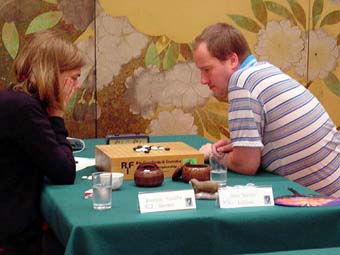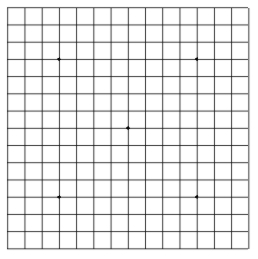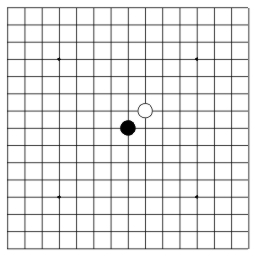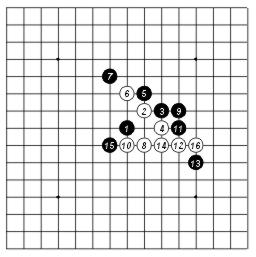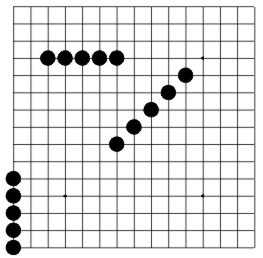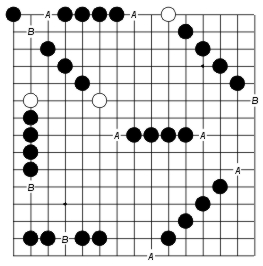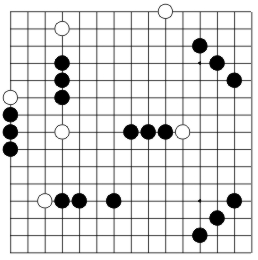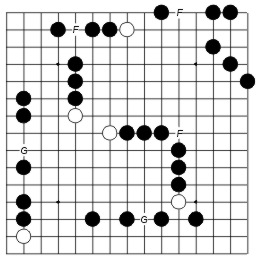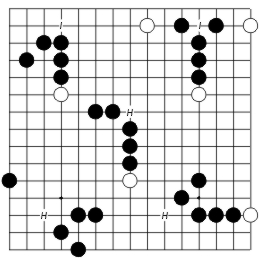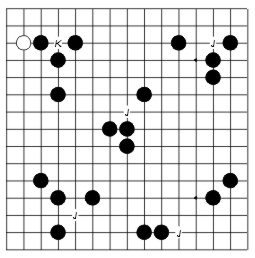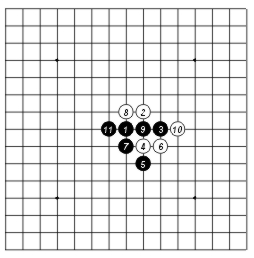|
What is Renju? Since you opened this page, you are likely a beginner in renju and you would like to know what this game is about about how to play it. If you want to read the official rules, you can click here [Renju Rules] but I am afraid this "theoretical" rules explanation is not very helpful for the beginner. Therefore, I recommend that you go through this beginner tutorial below. By reading through this page, you will get all the answers to your questions. Look at the picture below. There are two renju masters, playing a serious renju game. You can see the wooden board there, and the black and white stones. The picture is taken in the Renju World Championship.
If you want to take a close look at the board, it looks like the image below. The board has 15x15 lines.
At first, the board is empty. The player with the black stones begins the game. The first move has to be made to the center of the board. All the moves are placed on the lines intersections instead of placing them in the middle of the squares. It has been a long tradition for hundreds of years and we keep it, too. After that, white makes the move to any vacant spot on the board. For example, as shown on the image below.
The players take turns, placing the moves on the board. The stones that are already on the board should not be touched. The players can only add stones to the board. The player wins the game when he gets 5 of his own stones in a row. The example game is shown below. For better understanding, I put numbers on the stones, letting you understand the order of moves. Of course, in real game there are no numbers on the stones. White won the game by the 16th move, creating horizontal line of 5 white stones.
If you wonder now, if there can also be a vertical and diagonal winning line in renju, then the answer is yes. The diagram below shows the examples of all possible winning lines. As you may notice, it is also possible to play to the edge line of the board and even win there if the chance comes.
Now you already know the basics of the game. It seems easy at first, but if you actually start playing, you might realize it is not so easy to win at all. You spend lots of time to build a line, and just when you are so close to make a five in a row, your opponent simply blocks your way. In order to succeed in your play, you should understand some basic structures which can be very helpful in the attack. skillful usage of such structures will help you win the game. The attacking weapons are "threes" and "fours". They are dangerous weapons. If the opponent ignores them, and does not block them, you will win. A four is a line that threats to become five in a row on the next move. You can see the examples of fours on the diagram below.
On the diagram above, you can see the examples of all kinds of fours. Black can put 5 in a row from the points A or B. The fours with the mark "B" are half open fours. If it is white's turn in the game, white is able to defend by placing the white stone into point B. The fours that are marked with "A" are "open fours". This is the typical win situation in renju. Whenever the player succeeds to get an "open four" then it is impossible to defend, because both ends of the four are open, and no matter which end of the four opponent blocks, the other end will remain open and the 5 in a row will be achieved anyway. So, the main tactics of the player should be to create an open four. The open four can be created from the "open threes" only. On the diagram below, you can see the examples of "open threes". With the move C, the player can make an "open four".
If black has one of the threes as shown on the diagram above, and it was black's turn to play, then black could create an open four with the move C. Having the open four practically means win, as we learned before, therefore, the opponent should be very careful whenever the "open three" on the board. So, as long as the opponent doesn't have the win chance of his own, he should pay attention to our "open three" and block it. On the diagram below, you can see the possible ways of blocking an open three.
With any of the the move D, white can easily block the black's open three, after which the black line is no longer dangerous. Also, look at the points E. It is a very interesting situation. Thank's to the closeness of the white stone or the board's edge, white has three possible ways to block the open three - points E. Having put the white stone to any of the points E, black is unable to make an open four after that. So, the variety of defense moves is quite large. In practical renju games, you rarely see those "faraway" blocks. Most open threes are usually blocked tightly nearby.
Now you have understood the meanings of "open three" and "fours". All kinds of "fours" and "open threes" are powerful attacking weapons. However, if you just build one line at a time, you never succeed to win, unless your opponent's name is Forrest Gump. A wise opponent blocks all your "open threes" and "fours" and you have no chance to win like that.
In order to win against wise players, you need to use more complex attack methods. Simply saying, you should try to create a "fork" - a move that creates two attacking lines at the same time.
If you do so, then the opponent is in big trouble, because he has no time to block both of them, and one of the lines will then remain open, and you can win from it.
On the diagram below you can see the examples of double-four (4x4) forks, at the points F. The points G are also 4x4 forks, beautiful, aren't they.
On the next diagram you see the examples of four-three forks (4x3). They consist of one four and one OPEN three, just like shown on the points H. Please note that if the thee is "closed", then the 4x3 is NOT a winning fork, just like point I.
On the diagram below you can see the examples of double-three (3x3) forks, at the points J. Both threes must be "open threes", only then the fork is winning. If one of the thees is not an open three, then the fork is not winning, just like shown at the points K.
Now you have learned all the necessary tools for the attack. You must wonder, how would such fork situations appear in the real game. Ok, here is an example for you. Look at the diagram below. Black is attacking there. On the 11th move, black placed a 4x3 fork, and white player likely resigns here, because defense is hopeless. Move 10 was a mistake, as you probably guessed. The correct 10th move should have been on the left side of the black's three.
What you learned so far actually is not quite renju yet. The basic 5 in a row game is called gomoku. All the beginners start with learning gomoku at first, and after some time, they move on to renju. Renju is a bit more complex game, and there are more rules. While gomoku is just an easy family game, renju is a serious sport and there are even world championships in that game. Renju game was developed from from gomoku game by Japanese masters about 100 years ago. The reason why
gomoku was not satisfying for players any more was the fact that the skillful first player (black) could always win the game. Additional rules had to be made to balance the game and give the white player more chance for resistance. The game with those balance rules is called RENJU.
These restrictions are only for black side. White has no restrictions, and white can win the game even with overline. So, you may wonder, how can black win the game then. The answer is - black's only allowed winning fork is the four-three (4x3) fork. If you look at the diagram above once more, then you can see the pure renju game situation - black is winning with completely legal 4x3 fork. The aspect of "forbidden moves" brings a totally new tactical tool into renju game - trapping the forbidden points. That tool is a weapon only for white player. On the example diagram below you can see how the white player is taking advantage of the forbidden 3x3 fork and wins the game therefore. Since black is not allowed to play to the point X, black must play elsewhere, and white can win on the next move by making 5 in a row in point X. Really amazing, isn't it?
On the diagram below, you can see the short summary of black's forbidden moves, marked with Y. Black is not allowed to play onto these points. It is also important to notice that the point Z is not a forbidden move, because one of the threes is not an "open three". If you forgot what "open three" means, look over the diagrams again that explain the meaning of "open three".
It is about time for you to go and start playing renju, either at home with friends, or in online game servers with people all over the world. After some time, you will get more experience in renju, but also, you will probably have new questions about renju, and some rules still confuse you. Then it will be the time to take a look at the advanced tutorial of renju. |
